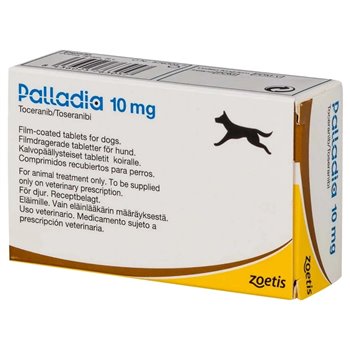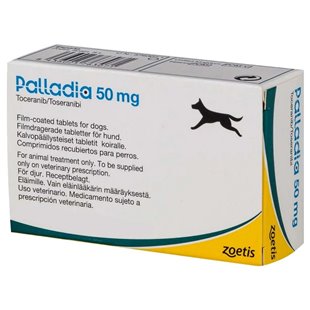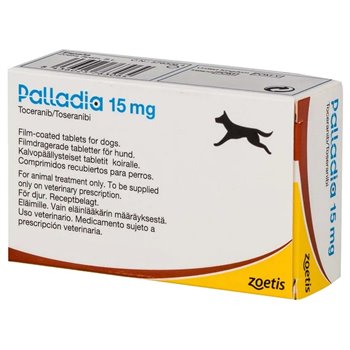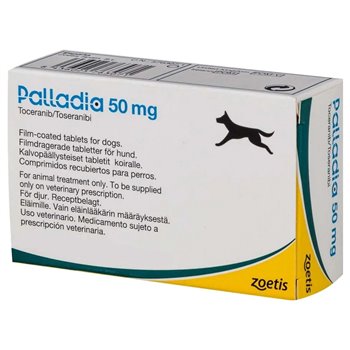Palladia Tablets for Dogs
Palladia Tablets for Dogs are used for the treatment of non-resectable Patnaik grade II (intermediate grade) or III (high grade), recurrent, cutaneous mast cell tumours in dogs.
A Vet Prescription is required for Palladia
Treating mast cell tumours with Palladia
Palladia is a medication used for the treatment of mast cell tumours in dogs, and is one of the new wave of anti-cancer medications that have recently become approved for use in pets. In this article, we will look at mast cell tumours in more detail, as well as how Palladia works and why it is often indicated in mast cell tumour treatment. Read on to learn more.
What are mast cell tumours?
Mast cell tumours are also known as mastocytomas, and are a type of round cell tumour that develops from the body’s mast cells. Mast cells form a part of the body’s immune system, and are mainly utilised to generate a reaction to allergens, as well as being an integral part of normal wound healing and defending the body against pathogens.
Mast cells are produced in the bone marrow, and can be found throughout the body of the dog in connective tissue, as a normal part of the immune system. Mast cells produce histamine, which is one of the body’s responses to allergic reactions and tissue damage.
Mast cell tumours occur due to abnormal or excessive growth of the body’s mast cells, and mast cell tumours may be either malignant or benign. Mast cell tumours can appear in many parts of the body and take on many different appearances, but in the vast majority of cases, a mast cell tumour will be a standalone problem, with only 6% of cases presenting as multiple tumours.
When the body’s mast cells become a malignant tumour, they degranulate and create inappropriate inflammation of the surrounding tissues. Malignant mast cell tumours are highly inflammatory, and can spread throughout the body, sometimes worsening simply as the result of a biopsy or other manipulation.
Around 25% of all tumours diagnosed in dogs are mast cell tumours.
What is Palladia?
Palladia for Dogs is an oral medication for the treatment of mast cell tumours in dogs. It is designed for the treatment of intermediate and high grade recurrent cutaneous mast cell tumours, or those affecting the skin, one of the most common sites for mast cell tumours.
Palladia was originally developed for use in humans, and was used off-label for the treatment of dogs for several years before it was awarded formal approval for canine use as the result of clinical trials.
The following strengths are available: 10mg Palladia, 15mg Palladia and 50mg Palladia
How does Palladia work?
Palladia is made of the active ingredient Toceranib phosphate, which is a tyrosine kinase inhibitor. This means that Palladia acts against mast cell tumours in two different ways: Firstly it disrupts the blood supply to the tumour, and secondly, it kills the cells of the tumour itself.
This means that Palladia can reduce the size of the tumour, potentially eliminating it entirely, and also that it stops persistent or recurrent tumours from growing and developing. Palladia for dogs works by targeting the specific proteins involved in the growth and spread of cancerous cells. It inhibits the activity of these proteins, effectively stopping the progression of the tumour. This mechanism of action allows Palladia to target the cancerous cells while sparing the healthy ones, thus reducing the overall side effects on your dog. The use of Palladia for dogs has been extensively studied and has shown promising results in clinical trials. In many cases, it has been reported to significantly reduce the size of the tumor, and in some instances, even complete tumor regression. This makes Palladia a vital treatment option for dogs suffering from mast cell tumors.
Is Palladia suitable for use in all dogs?
Palladia for Dogs should not be given to dogs under two years of age, or those that weigh less than 3kg. It is also not suitable for bitches that are pregnant or lactating, or that are intended to be used for breeding later on.
If the tumour is deemed as treatable with surgical intervention, this should be the first choice of treatment before Palladia is considered. Palladia is not suitable for dogs that suffer from gastrointestinal ulcers of bleeds.
Dogs that are prescribed Palladia should be monitored carefully to ensure that the drug is proving effective, and that any potential side effects of the medication are not negating the beneficial effects of the drug.
During the initial stages of treatment, the treatment protocol should be reviewed weekly for the first six weeks, and after this time, at six-weekly intervals or as advised by your veterinary surgeon.
Dosage and adjustments to the relevant dosage for any dog should be based on blood cell count and serum chemistry panels, as well as urinalysis and clinical observation.
How is Palladia given?
Palladia is provided in tablet form in different sizes, prescribed according to the bodyweight of the dog. The tablets can be given either with or without food, and should be swallowed. Generally, Palladia is given at the rate of one tablet per day, every other day. Always administer Palladia in accordance with your vet’s guidelines.
Where can I buy Palladia for Dogs?
Palladia for Dogs is a POM-V medication, meaning that it can only be bought with a veterinary prescription. If your vet recommends treating your dog’s mast cell tumour with Palladia, you can ask your vet to provide you with a veterinary prescription to buy the product from us.
Palladia should only ever be given to the dog for which it is prescribed, and you should not stop giving Palladia or change your dog’s dosage without first consulting with your vet first.










